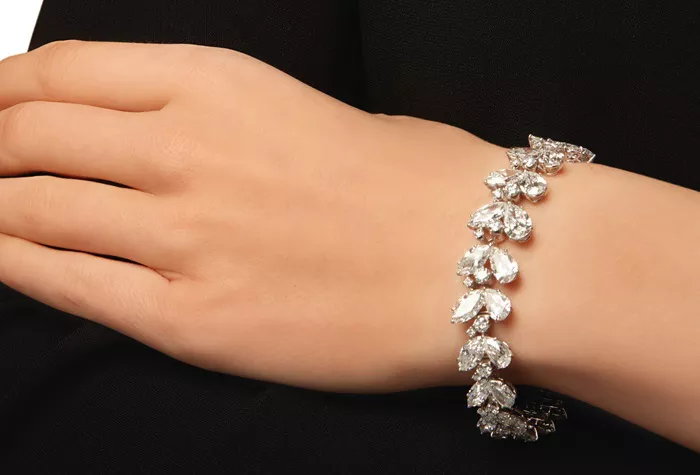Diamond bracelets are a beautiful and valuable investment, cherished for their timeless sparkle and elegance. However, many owners wonder whether it’s safe to wear their diamond bracelets while showering. While diamonds are incredibly durable, there are several factors to consider when it comes to protecting both the stones and the bracelet’s metal components. This article delves into the risks of showering with a diamond bracelet, the importance of regular maintenance, and how to keep your jewelry looking its best.
Risks of Showering with a Diamond Bracelet
Although diamonds are one of the hardest substances on Earth, wearing a diamond bracelet in the shower can still lead to a variety of issues:
Soap and Residue Build-Up: When you shower, soap, shampoo, and conditioner can leave a residue film on the surface of your diamonds. Over time, this can dull the brilliance and sparkle of the stones, making them look lackluster. The build-up of these residues can be difficult to remove without regular cleaning.
Water Damage: While diamonds themselves are not affected by water, the metal settings and clasps of your bracelet can be. Prolonged exposure to water, especially hot water, can lead to the weakening of the metal, tarnishing, or even rusting in some cases. This can compromise the overall strength of the bracelet and its ability to securely hold the diamond.
Chemicals in Shower Products: Many shower products, such as shampoos, body washes, and exfoliating scrubs, contain harsh chemicals. These chemicals can be harmful to the metal setting of your bracelet over time, causing tarnishing, discoloration, or weakening of the precious metal. For example, chlorine, found in some body washes or soaps, can cause damage to certain metals like gold or silver.
Advice on Removing Jewelry
To maintain the appearance and integrity of your diamond bracelet, it’s highly recommended to remove it before showering. Here are some helpful tips:
Create a Routine: Make it a habit to remove your bracelet and other jewelry before entering the shower. Consider designating a safe spot, such as a jewelry dish or soft pouch, where you can store your pieces while you shower.
Safe Storage: Keep your bracelet in a secure place when it’s not being worn. Avoid leaving it in a damp area, as moisture can increase the risk of tarnishing. Storing it in a soft-lined box or a cloth pouch helps prevent scratches and keeps it clean.
Cleaning and Maintenance
Proper care and maintenance are essential for keeping your diamond bracelet looking its best:
Regular Cleaning: Clean your bracelet regularly to remove soap and product residue. Use a soft brush and mild soap (such as dishwashing liquid) mixed with warm water. Gently scrub the diamond and metal settings, paying special attention to hard-to-reach areas. Be sure to rinse it thoroughly to remove any soapy residue.
Professional Cleaning: Even with regular at-home cleaning, it’s important to bring your diamond bracelet to a professional jeweler for cleaning and inspection periodically. A jeweler can deep clean the bracelet, check the prongs, and ensure that the diamond is securely set.
Water-Resistant vs. Waterproof Jewelry
It’s crucial to distinguish between water-resistant and waterproof jewelry:
Water-Resistant Jewelry: Most diamond bracelets are designed to be water-resistant, meaning they can handle brief exposure to water but are not intended for prolonged contact, such as submerging in water or wearing while showering.
Waterproof Jewelry: Waterproof jewelry, on the other hand, is designed to withstand continuous exposure to water. However, this category typically applies to items made from materials like silicone, rubber, or stainless steel—not precious metals or diamonds.
Alternatives for Daily Wear
If you need to wear a bracelet that can withstand exposure to water, there are some alternative materials that are better suited for this purpose:
Silicone Bracelets: These are water-resistant, lightweight, and durable, making them ideal for daily wear in the shower. They won’t tarnish or discolor, and they’re a great option for a practical, everyday piece.
Stainless Steel Bracelets: Stainless steel is resistant to rust, tarnish, and corrosion, which makes it a great alternative for those who need a bracelet that can withstand water and chemicals without compromising its appearance.
Plastic or Rubber Bracelets: Similar to silicone, these materials can handle water exposure without getting damaged. They are often used for sports or casual settings.
Protecting Your Investment
Your diamond bracelet is not only a beautiful accessory but also a significant investment. Taking the right steps to protect it from unnecessary wear and tear ensures that it remains in top condition for years to come. By following simple precautions like removing your bracelet before showering, regularly cleaning it, and getting professional maintenance, you can preserve its beauty and value.
Remember that proper care will not only protect your diamond’s brilliance but will also help to maintain the structural integrity of the bracelet itself. Avoiding exposure to harsh conditions, such as water and chemicals, is key to preserving the quality of your piece.
Conclusion
While diamonds are durable, showering with a diamond bracelet is not recommended. The combination of water, soap, and chemicals can dull the diamond’s sparkle and damage the metal setting. To maintain the bracelet’s appearance and ensure its longevity, it’s best to remove it before showering. Regular cleaning and professional maintenance will also help preserve the beauty and integrity of your diamond bracelet. By following these simple steps, you can continue to enjoy the elegance of your jewelry while protecting your investment.
Related topics:

